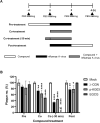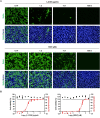Antiviral activity of lambda-carrageenan against influenza viruses and severe acute respiratory syndrome coronavirus 2
- PMID: 33436985
- PMCID: PMC7804421
- DOI: 10.1038/s41598-020-80896-9
Antiviral activity of lambda-carrageenan against influenza viruses and severe acute respiratory syndrome coronavirus 2
Abstract
Influenza virus and coronavirus, belonging to enveloped RNA viruses, are major causes of human respiratory diseases. The aim of this study was to investigate the broad spectrum antiviral activity of a naturally existing sulfated polysaccharide, lambda-carrageenan (λ-CGN), purified from marine red algae. Cell culture-based assays revealed that the macromolecule efficiently inhibited both influenza A and B viruses with EC50 values ranging from 0.3 to 1.4 μg/ml, as well as currently circulating severe acute respiratory syndrome coronavirus 2 (SARS-CoV-2) with an EC50 value of 0.9 ± 1.1 μg/ml. No toxicity to the host cells was observed at concentrations up to 300 μg/ml. Plaque titration and western blot analysis verified that λ-CGN reduced expression of viral proteins in cell lysates and suppressed progeny virus production in culture supernatants in a dose-dependent manner. This polyanionic compound exerts antiviral activity by targeting viral attachment to cell surface receptors and preventing virus entry. Moreover, its intranasal administration to mice during influenza A viral challenge not only alleviated infection-mediated reductions in body weight but also protected 60% of mice from virus-induced mortality. Thus, λ-CGN could be a promising antiviral agent for preventing infection with several respiratory viruses.
Conflict of interest statement
Y.J., H.S., M.K.L, O.S.K., J.S.S., C.W.K., H.-R.L., and M.K. declare no conflict of interest. Y.K. is trying to commercialize λ-CGN used in this study through the company Hanmi Pharmaceutical Co.
Figures







Similar articles
-
Inhibition of influenza A virus and SARS-CoV-2 infection or co-infection by griffithsin and griffithsin-based bivalent entry inhibitor.mBio. 2024 May 8;15(5):e0074124. doi: 10.1128/mbio.00741-24. Epub 2024 Apr 9. mBio. 2024. PMID: 38587427 Free PMC article.
-
Biocompatible Iron Oxide Nanoparticles Display Antiviral Activity Against Two Different Respiratory Viruses in Mice.Int J Nanomedicine. 2024 Dec 21;19:13763-13788. doi: 10.2147/IJN.S475323. eCollection 2024. Int J Nanomedicine. 2024. PMID: 39723174 Free PMC article.
-
Taurultam shows antiviral activity against SARS-CoV-2 and influenza virus.BMC Microbiol. 2025 May 15;25(1):292. doi: 10.1186/s12866-025-03847-2. BMC Microbiol. 2025. PMID: 40375181 Free PMC article.
-
An updated and comprehensive review of the antiviral potential of essential oils and their chemical constituents with special focus on their mechanism of action against various influenza and coronaviruses.Microb Pathog. 2021 Mar;152:104620. doi: 10.1016/j.micpath.2020.104620. Epub 2020 Nov 16. Microb Pathog. 2021. PMID: 33212200 Free PMC article. Review.
-
Perspective of Use of Antiviral Peptides against Influenza Virus.Viruses. 2015 Oct 20;7(10):5428-42. doi: 10.3390/v7102883. Viruses. 2015. PMID: 26492266 Free PMC article. Review.
Cited by
-
Characterization and Gel Properties of Low-Molecular-Weight Carrageenans Prepared by Photocatalytic Degradation.Polymers (Basel). 2023 Jan 24;15(3):602. doi: 10.3390/polym15030602. Polymers (Basel). 2023. PMID: 36771902 Free PMC article.
-
Marine Sulfated Polysaccharides as Promising Antiviral Agents: A Comprehensive Report and Modeling Study Focusing on SARS CoV-2.Mar Drugs. 2021 Jul 22;19(8):406. doi: 10.3390/md19080406. Mar Drugs. 2021. PMID: 34436245 Free PMC article.
-
The Anti-Viral Applications of Marine Resources for COVID-19 Treatment: An Overview.Mar Drugs. 2021 Jul 23;19(8):409. doi: 10.3390/md19080409. Mar Drugs. 2021. PMID: 34436248 Free PMC article. Review.
-
Inhibition of endocytic uptake of severe acute respiratory syndrome coronavirus 2 and endo-lysosomal acidification by diphenoxylate.Antimicrob Agents Chemother. 2024 Jun 5;68(6):e0034124. doi: 10.1128/aac.00341-24. Epub 2024 May 14. Antimicrob Agents Chemother. 2024. PMID: 38742905 Free PMC article.
-
Advances in the Prophylaxis of Respiratory Infections by the Nasal and the Oromucosal Route: Relevance to the Fight with the SARS-CoV-2 Pandemic.Pharmaceutics. 2022 Feb 27;14(3):530. doi: 10.3390/pharmaceutics14030530. Pharmaceutics. 2022. PMID: 35335905 Free PMC article. Review.
References
Publication types
MeSH terms
Substances
LinkOut - more resources
Full Text Sources
Other Literature Sources
Molecular Biology Databases
Miscellaneous

